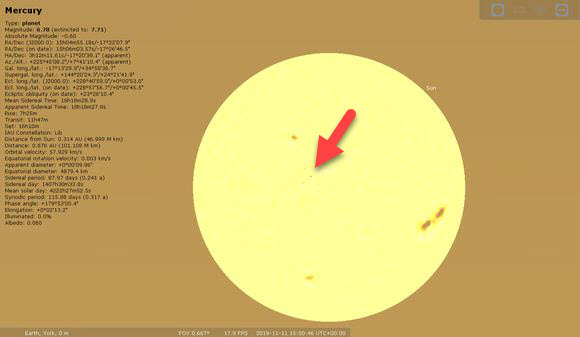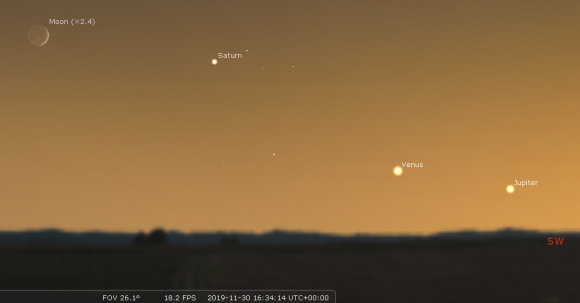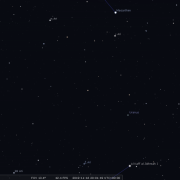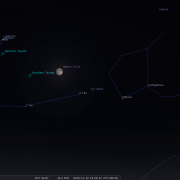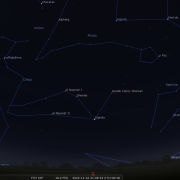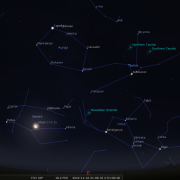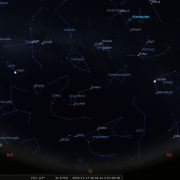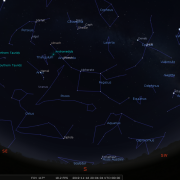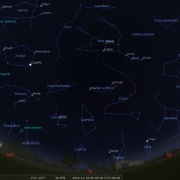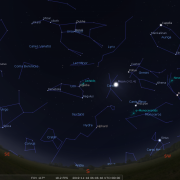Welcome to the WDAS monthly newsletter for November 2019: a digest of the month's latest contributions to our website. Below you'll find Society News: past and coming events, a hint of Christmas dinner, and of course your monthly Sky Notes.
This month sees a transit of Mercury across the Sun, and a plethora of planetary conjunctions... full details below!
And don't forget: the Dark Sky event in Danby is tomorrow (2nd November)... come along and help if you can.
Society News
This is before our next monthly meeting so better give details here.
The venue is the same as usual –Danby Moors Centre with the programme along similar lines to the previous ones. So, after getting there and deciding its too cloudy/ too rainy/ too windy/too snowy.. etc we shall be hosting an indoor show. But let’s not be too pessimistic, we are due some fair weather...surely, especially on a weekend and I’m confident Saturday 2nd is when it commences. The event is public bookable and hopefully around 50-60 will have done so.
We are starting a little earlier this year, (18:00h) hopefully so that we can make the most of any views of Saturn, so we need to be on site for 17:35h allowing time to set up, whatever that may be. Transportation will be key – especially if conditions are liable to be good for observing.
If you can make it along, please meet at Marks house: 33 Laburnum Grove – Whitby for 17:10h.
It’s been a while since i was last in the ‘drill hall’ on Bagdale, spent many an hour there in the past. This was (and always has been) the venue for the Scouts, and as conditions in the sky were once again no good for observing, it was our destination on 3rd October 2019.
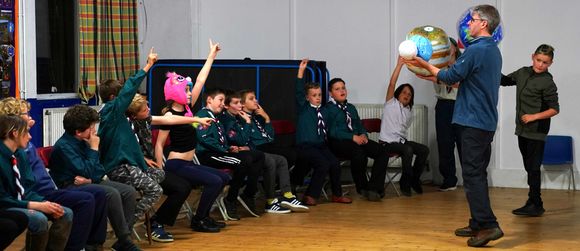
Keith and Mark saw to duties, the usual mix of boisterous demonstrations and a presentation. The white washed wall served brilliantly as a large screen, with the spectacular images of deep sky objects particularly going down well. The scouts appeared to enjoy the evening, hopefully next time getting to look through a telescope.
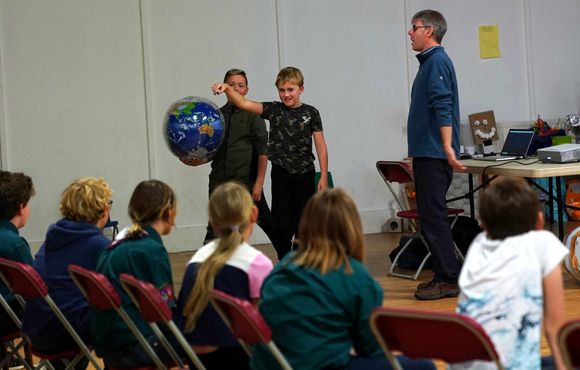
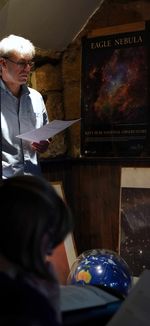 As you may know this was originally intended to be a two evening event, however as interest was more forthcoming for just the Saturday, Colin and Vicky dropped the Friday evening from the program. Friday, as it transpired was a clear night, great for observing. Saturday was ‘orrid (at least it wasn’t windy), and although the BBC forecast still offered some optimism, the Met office one did not. The Met office was correct and any lingering hopes of some clear breaks were quickly extinguished by the rain.
As you may know this was originally intended to be a two evening event, however as interest was more forthcoming for just the Saturday, Colin and Vicky dropped the Friday evening from the program. Friday, as it transpired was a clear night, great for observing. Saturday was ‘orrid (at least it wasn’t windy), and although the BBC forecast still offered some optimism, the Met office one did not. The Met office was correct and any lingering hopes of some clear breaks were quickly extinguished by the rain.
Having already made one journey up to Ainthorpe during Saturday morning to drop off a couple of Dobsonians (insurance policy...just in case), as well as the inflatables and screen, Mark and Keith, along with the remainder of the necessary paraphernalia, made their way up to the Fox & Hounds for 16:30h in light and intermittent precipitation (probably the high watermark of ‘reasonable’ weather that night).
After being warmly greeted by Colin, Vicky and staff on arrival, Keith and Mark set about making the games lounge fit for the background of a ‘Sky at Night’ episode. Actually, Colin and the staff had already inflated the planets, which was a welcome surprise and saved a considerable amount of time. The poster boards, a Tal refractor, even meteorite samples, all added to the look of an astronomical themed event. Soft drinks and biscuits were on hand, although a number of ‘harder beverages’ also appeared.

Around 14 people had initially booked for the evening (which included dinner) and although there were a couple of cancellations (due to the weather I suspect), proceedings were delayed only slightly. Following introductions and with a captive audience, Mark spent the first hour of the indoor show using the SN8 program, touring the night sky as it should have appeared that evening, before going on to highlight some forthcoming astronomical events.
At around 18:30h we adjourned to the restaurant room for dinner, having made our menu choices earlier. The cuisine and service was excellent, and with the room to ourselves, we chatted about all kinds astronomical topics. It was agreed there was little chance of performing demonstrations outside, so we returned to the games room suitably stuffed refreshed for part two of the evening. This was composed of some Earth-Moon scale demo’s, followed by some more on a grander theme. The final part of the evening was spent looking at various types of deep sky objects, taking us to 22:00h.

Despite the rain and general grotty conditions, people hopefully took something away from the evening. We certainly enjoyed the night, and are set to return in late February or early March for the Dark Sky event Colin and Vicky have signed up to with the national parks. Hopefully then, the weather will see fit to facilitate some outdoor observing this venture Colin and Vicky are seeking to promote long term deserves.
Many thanks for the hospitality shown by Colin and Vicky and the Fox and Hounds staff, a venue which we thought was quite impressive and are eager to see just as much as Colin and Vicky are, how much potential this observing site offers, not only in terms of viewing, but public comfort.
To be discussed at the November meeting and booked shortly after.
The final star party in October, requested and organized by Chloe Barker and tied into ‘The Unblinking Eye: 55 years of space operations on Fylingdales Moor’ exhibition at the museum, looked most unlikely to go ahead less than six hours before it was due to begin.
Rain was still failing during Saturday afternoon 24 hours after it had started! However the forecast (and crucially the timing of it) was right for once, with colder, clearer conditions spreading down by late afternoon, just in time for the event to get a green light.

The party location was to the rear of Archery green on the West Cliff, and my, was the ground sodden; the grassy car park next to the pitch and putt was exceedingly messy and wet (it was also the 25th Goth weekend and the town was bursting, with cars parked all over the place).
Mark, who was met at the location by Keith, had brought just the two Dobsonians along and having eventually located some firmer, less muddy and squelchy ground, they set up the equipment. Chloe joined us soon after with a very small party who had not cancelled. Elaine, Phil and Richard also made it along and with a few members of the public coming over, there was a decent little gathering given the nature of the day.

Conditions were rather chilly and a little breezy, but UK astronomers are hardy souls, and with clear skies overhead we set about targeting a few objects. Jupiter was close to departing and looked decidedly ‘wobbly’ through the eyepiece. Saturn on the other hand was a reasonable prospect with the rings and Titan quite well resolved. Other ports of call included M57, M13, Alberio, M31, Mizar and M27, whilst also giving a laser pointer tour of the constellations, brighter stars and other luminaries of interest.
Mark even spotted a meteor, when everyone else was looking in the other direction... honest guv! Although the event was only an hour in duration, it was nevertheless most enjoyable, only near the end did Elaine’s proposal to decamp to warmer climes...Jamaica or St Lucia, seem to make perfect sense!
(See all images form WDAS 2019 Events in the Gallery!)
Sky Notes
In this month's Sky Notes:
Transit of Mercury
The undoubted highlight of the month is a transit of Mercury across the suns disk on Nov 11th. Being the innermost planet, transits of Mercury are more frequent than those of Venus, but are still not commonplace events.
Mercury is a small world and consequently resembles only a tiny black dot on the face of the sun. You will therefore require a telescope to observe it, but anything in excess of 30X magnification should suffice. The transit commences around 12:39h from this area, with mid transit occurring at 15:20h and finishing after 18:00h, however as the sun sets shortly after 16:00h, the latter part of the transit will not be visible.
And Now the Obligatory Solar Warning Message:
- Never look directly at the Sun with any optical aid (even your naked eye) without using suitable solar filters or solar viewing techniques.
- You may use neutral density or Mylar solar film, fashioned to fit over the objective end of your telescope (never the eyepiece).
- Alternatively you can try projecting the image of the sun onto a card, preferably in shade, so you can see the tiny black dot. Be careful using this method, do not be tempted to look through the finder scope (if fitted), blank it off or remove it. Align on the sun by aiming roughly in its direction and look for the smallest shadow of the telescope cast on the ground.
- Do not use any ‘screw on’ eyepiece solar filter sometimes supplied with cheaper scopes. Introduce such a filter to a hammer!
- If you require further advice please contact me by email. Further details will be given at the monthly meeting on the 5th.
Planetary Skylights
Evening Planets
This November sees a plethora of planetary conjunctions; indeed all five naked eye planets are visible, with Uranus and Neptune available for telescopic observation as well. Seven planets! Look down… that makes eight!
The downside is that all the naked eye planets are located around the margins; close to the horizon either just after sunset or shortly before sunrise and therefore not best placed for ‘meaningful scrutiny’. The upside is that given some clear skies, some great photo opportunities await.

 Jupiter continues to loiter just above the WSW horizon all month and has been joined by brilliant Venus. You will require a clear view of this aspect to appreciate the planetary fun and games, especially so during the last week of November when the pair are involved in some spectacular conjunctions.
Jupiter continues to loiter just above the WSW horizon all month and has been joined by brilliant Venus. You will require a clear view of this aspect to appreciate the planetary fun and games, especially so during the last week of November when the pair are involved in some spectacular conjunctions.
Observe as twilight descends, which by the end of the month is around 16:30h. You should easily spot both planets; Venus will be the more conspicuous, and a little lower. It is however slowly gaining in altitude and eventually will come to dominate the evening sky in the west.
The two planets are closest together on the 24th and 25th, but the spectacular conjunction is enhanced further when on the 28th a new crescent Moon emerges, gate crashing the party, before moving on to highlight Saturn the following evening.
 Saturn resides a little further round to the SW. If skies are clear, lighting conditions will afford an excellent opportunity for some photos. As visually attractive as the vista may look to the naked eye, telescopic views of the planets will be somewhat disappointing, the turbulent air making for unsteady seeing, although at the start of November Saturn will still be a viable target.
Saturn resides a little further round to the SW. If skies are clear, lighting conditions will afford an excellent opportunity for some photos. As visually attractive as the vista may look to the naked eye, telescopic views of the planets will be somewhat disappointing, the turbulent air making for unsteady seeing, although at the start of November Saturn will still be a viable target.
 Having reached opposition towards the end of last month, Uranus is well placed to track down and observe through a telescope. In fact keen sighted people observing from a dark location may be able to spot it with just the naked eye (assuming they know exactly where to look).
Having reached opposition towards the end of last month, Uranus is well placed to track down and observe through a telescope. In fact keen sighted people observing from a dark location may be able to spot it with just the naked eye (assuming they know exactly where to look).
Uranus resides just within the borders of Aries, but is some distance below the ‘crooked line’ asterism of the Ram. If you have a constellation chart or App etc, use Mesarthim and Iota Aries as pointers to locate Uranus, which resides three times the distance between these stars and a tad to the right, below them. Through binoculars Uranus resembles a rather faint star of subtle grey/green hue. You will require a telescope to discern its very small disk.
 Neptune resides in the constellation of Aquarius just under a degree lower right of the star phi aqr. You will require a telescope to spot its diminutive disk, which is fainter than all visible naked eye stars, but it does appear blue/grey in hue.
Neptune resides in the constellation of Aquarius just under a degree lower right of the star phi aqr. You will require a telescope to spot its diminutive disk, which is fainter than all visible naked eye stars, but it does appear blue/grey in hue.
Morning Planets
The November dawn also harbours a planet or two, with Mars and eventually Mercury both visible to the naked eye. A clear view of the ESE horizon is essential, especially from the 23rd onwards observing from around 06:30h.

 Look for elusive Mercury climbing above the horizon up to ten degrees and joining amber hued Mars located to the upper right. At this stage Mars will be brighter of the two, although not by much. Mercury brightens as it moves through its apparition, so that it will appear the dominant planet by late November/early December. It will continue to brighten, but will then be sinking back down into the glare near the horizon before sunrise and therefore more difficult to spot. The optimum period will be during the last week of November. View on the 24 and 25th when a very slim waning crescent Moon resides above Mars, and then to the left of Mercury. Mercury reaches greatest elongation from the sun on November 28th. Use binoculars if you are having difficulty spotting Mercury initially.
Look for elusive Mercury climbing above the horizon up to ten degrees and joining amber hued Mars located to the upper right. At this stage Mars will be brighter of the two, although not by much. Mercury brightens as it moves through its apparition, so that it will appear the dominant planet by late November/early December. It will continue to brighten, but will then be sinking back down into the glare near the horizon before sunrise and therefore more difficult to spot. The optimum period will be during the last week of November. View on the 24 and 25th when a very slim waning crescent Moon resides above Mars, and then to the left of Mercury. Mercury reaches greatest elongation from the sun on November 28th. Use binoculars if you are having difficulty spotting Mercury initially.
 Mars continues to pull slowly away from the ESE horizon. At Mag +1.5 it is not overly bright, but is decidedly orange in hue. From the 9th-11th Mars overtakes the bright star Spica – so do not confuse the two.
Mars continues to pull slowly away from the ESE horizon. At Mag +1.5 it is not overly bright, but is decidedly orange in hue. From the 9th-11th Mars overtakes the bright star Spica – so do not confuse the two.
 If you fancy trying to spot a minor planet, Vesta comes to opposition on the 12th and will be visible all night. At the start of the month it resides in Taurus near the border with Cetus. On the 4th,5th and 6th it passes just below the star omicron Tauri. This may be the optimum period to track Vesta down as it close to omicron and distant from moonlight. By the 12th the Full moon will be in the vicinity and Vesta will have moved over the border into Cetus, though still just a degree to the right of Omicron Tauri. At Mag + 6.5 Vesta is borderline naked eye, however binoculars will show it easily and its identity will be betrayed by its fairly rapid motion over consecutive nights.
If you fancy trying to spot a minor planet, Vesta comes to opposition on the 12th and will be visible all night. At the start of the month it resides in Taurus near the border with Cetus. On the 4th,5th and 6th it passes just below the star omicron Tauri. This may be the optimum period to track Vesta down as it close to omicron and distant from moonlight. By the 12th the Full moon will be in the vicinity and Vesta will have moved over the border into Cetus, though still just a degree to the right of Omicron Tauri. At Mag + 6.5 Vesta is borderline naked eye, however binoculars will show it easily and its identity will be betrayed by its fairly rapid motion over consecutive nights.
05 and 12-Nov-2019 at 19:30h (general SE direction). Dwarf Planet Vesta
Location Charts. (Click for full-sized images)
Meteors

- The Leonids are active from 15-20th Nov with the 2019 peak over the night of the 18th. A last quarter moon will also be visible in the sky, so observed numbers will be diminished by moonlight. For most years Leonid rates are around 25 per hour, rising to 100s if not 1,000s during ‘storm’ years, which occur at intervals of roughly 33 years, coinciding with the return of the periodic parent comet Temple Tuttle. The next storm years are expected sometime after 2030. With the unfavourable conditions this year (moonlight) expect to witness around a dozen per hour in the early morning hours. Leo rises late in the evening.
- South Taurids (04 to 05-Nov): Also during November keep an eye out for a few meteors on the night of Nov 4/5th when the South Taurid meteor shower reaches a peak
- North Taurids (11/12-Nov): Then look again on the night of Nov 11/12th when the North Taurid meteor shower peaks. The hourly rate is low; only around 5 meteors, but although few, Taurids can produce a few fireballs! The Taurids are an old shower, associated with the periodic Comet Enke. Over time dust from this comet has been depleted and spread out over a broad swath of the inner solar system, giving rise to Taurid meteor showers not only on Earth but also on Mars and Venus.
November 2019 Sky Charts
|
Looking North
Mid-November - 21:00h |
Looking South |
|
Looking East
Mid-November - 21:00h |
Looking West
Mid-November - 21:00h |
|
Northern Aspect
Mid-November - 20:00h |
Southern Aspect
Mid-November - 20:00h |
| Looking North (Early) Mid-November - 06:00h |
Looking South (Early) Mid-November - 06:00h |
Additional Image Credits:
- Planets and Comets where not otherwise mentioned: NASA
- Sky Charts: Stellarium Software
Misc
We will be putting in an order for 25 copies of Night Scenes 2020, however they are not expected out until late November, so we may have to be a little patient. Having emailed Paul Money regarding the 2020 edition, he said that Night Scenes nearly didn’t happen at all this year, with Paul encountering both promotional and distribution issues as well as financial decisions to make.
It will soon be time for sub renewal’s for the coming year.
Happily society subscription rates will be kept at the same level as last year, i.e £12, for adults with subsidized rates at £8 for under 16’s.
You can bring subs along to the W.D.A.S monthly meetings in December, January or February at the very latest.
If you cannot make the meetings Cheques are made payable to: Whitby & District Astronomical Society. Please address to Mark Dawson, 33 laburnum Grove, Whitby. YO21 1HZ.
Events
 Observe the night sky with us at the Bruce Observatory, Whitby School
Observe the night sky with us at the Bruce Observatory, Whitby School
Observing Nights are held weather permitting: check for a relatively clear sky before leaving home. If in doubt, Mark can be reached on 07886069339
Please note the college drive gate is now operated via a electronic key code - so anyone wishing to attend must be at the car park at the top of the drive by 19:00hrs - unless an arrival time has been arranged with Mark/Keith.
 Whitby School - Room H1.
Whitby School - Room H1.
In Members' monthly meetings we usually take a tour of the night sky for the coming month using the Planetarium program. Have talks and presentations on various topics of astronomy/space etc, and discuss future events etc. New members welcome.
 Observe the night sky with us at the Bruce Observatory, Whitby School
Observe the night sky with us at the Bruce Observatory, Whitby School
Observing Nights are held weather permitting: check for a relatively clear sky before leaving home. If in doubt, Mark can be reached on 07886069339
Please note the college drive gate is now operated via a electronic key code - so anyone wishing to attend must be at the car park at the top of the drive by 19:00hrs - unless an arrival time has been arranged with Mark/Keith.
 Observe the night sky with us at the Bruce Observatory, Whitby School
Observe the night sky with us at the Bruce Observatory, Whitby School
Observing Nights are held weather permitting: check for a relatively clear sky before leaving home. If in doubt, Mark can be reached on 07886069339
Please note the college drive gate is now operated via a electronic key code - so anyone wishing to attend must be at the car park at the top of the drive by 19:00hrs - unless an arrival time has been arranged with Mark/Keith.
 Observe the night sky with us at the Bruce Observatory, Whitby School
Observe the night sky with us at the Bruce Observatory, Whitby School
Observing Nights are held weather permitting: check for a relatively clear sky before leaving home. If in doubt, Mark can be reached on 07886069339
Please note the college drive gate is now operated via a electronic key code - so anyone wishing to attend must be at the car park at the top of the drive by 19:00hrs - unless an arrival time has been arranged with Mark/Keith.
 Whitby School - Room H1.
Whitby School - Room H1.
In Members' monthly meetings we usually take a tour of the night sky for the coming month using the Planetarium program. Have talks and presentations on various topics of astronomy/space etc, and discuss future events etc. New members welcome.



